USS Hikaru Sulu
More actions
USS Hikaru Sulu (NCC-92420) is an Odyssey-class Federation starship currently assigned to Fourth Fleet. She was previously under the command of Captain Raveen Shavda.
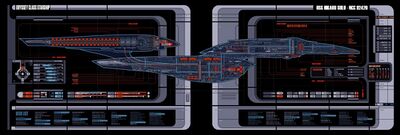
The first starship to bear the name, the vessel is named in honor of the eponymous 23rd Century commander of the original USS Excelsior (NCC-2000), Captain Hikaru Sulu.
It was assigned to duty along the former Demilitarized Zone, the deployment of a significant capital ship-of-the-line asset, such as the Odyssey-class, is purposefully designed by Starfleet Command to send an unequivocal message to both the forces of the New Marquis and True Way paramilitaries that the United Federation of Planets is still perfectly capable of flexing it’s martial muscle, whilst ostensibly supporting the missions of all operationally–deployed TF72 assets by serving as a mobile C&C hub and support vessel.
Dedication Plate
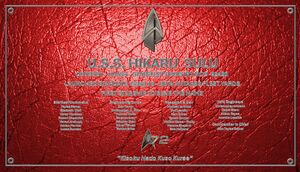
Housed immediately outside of the CO’s Ready Room on Deck 2, the ship's dedication plate is fashioned out of tooled red leather with silver embossed dedications to this, the first ship to carry the name.
The ship's motto, “Kisoku nado mushi shi te shimae” (規則など無視してしまえ), is expressed in Romaji-Japanese text and is directly attributed to Captain Sulu himself, once stating “Let the Regulations be Damned”, harking back to a rougher 23rd century reality where Starfleet captains often had to react to changing exigencies, rather than act ‘by the book’.
Design & Layout
Bridge
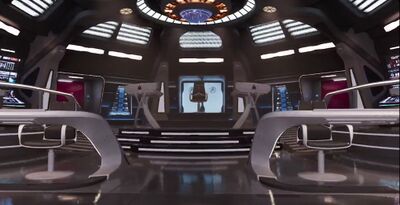
The bridge of the USS Hikaru Sulu follows the 25th century school of naval design that favors austere, clean decks and utilizes both a high degree of automation and configurable holographic displays.
With a conference room situated directly behind the captain’s chair on its raised dais, immediately flanked by twin turbolifts, the bridge features two standing–consoles directly ahead of the “Big-Chair”, where the Operations and Tactical operations are directed from. Fore of this position are two seated control consoles for Helm & Navigation. Flanking the captain to starboard is the Main Science station, with an additional configurable standing station facing fore and similarly, the Main Engineering station is situated to port, with another standing station.
The traditional MSD display aboard the Odyssey–class is holographic and summoned upon need, leaving the bridge very uncluttered, considering the vessel’s size and complexity. This aesthetic is also continued by the fact that in a departure from decades of practice, the CO’s dayroom is not directly adjacent to the bridge, rather it is situated one deck down on Deck 2.
Flag Bridge

The Odyssey–class is a capital ship with the capacity to host a flag–officer and accordingly has a flag bridge, or ‘Strategic Operations Centre’ (SOC) as it is more commonly referred to, as that is its primary function. Whether the USS Hikaru Sulu is currently serving as a flagship or engaged in the more routine task of day-to-day fleet coordination.
Situated on Deck 14, the SOC hosts every system a senior officer needs to maintain coordination of fleet assets over a wide area of influence and is the locus of the Odyssey–class’s powerful communications capability and sensor arrays. The space is typically supported by the vessel’s Strategic Operations Officer and Intelligence Officer, along with a number of communications and operations personnel.
When the saucer and secondary hulls operate in separated mode, the flag bridge serves as the command-and-control space for the secondary, typically with the ship’s executive officer in nominal command of the element and a second watch rotation to crew the attendant systems.
Promenade
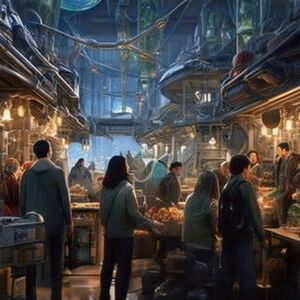
With its immense size and utility, the USS Hikaru Sulu is able to offer an unparalleled shore–leave experience for members of visiting crews unable to return directly to Starbase 72. Jewel in this recreational crown is the Promenade deck, colloquially known as the “Electric Mile”, an ever-changing, sprawling holographic street market that is able to constantly reconfigure its offerings to host a range of pan-species experiences, festivals and holidays. As they say aboard, “If you’re tired of the Electric Mile, you’re probably dead!”.
Mission Operations
Command & Control
With its capacity to host a senior officer of flag–rank and its comprehensive and powerful communications system, the Hikaru Sulu is ideally suited to the complex coordination of Starfleet assets and actions within the volume it operates in. Where Task Force vessels are operating far from the immediate sphere of control in Minos Korva or are engaged in deep space exploration, the Odyssey-class excels in keeping them connected & informed.
Diplomacy
Aside from the graceful Obena–class, the Odyssey-class represents an unparalleled platform for the conduct of complex, multiparty diplomatic summits, symposia, trade negotiations, delegate transport, courier and a host of other services intended to further Task Force 72’s core mission of peace through diplomacy. Such is the capability of the class that it is also able to perform consular services for Federation citizens and provide long-term accommodations & support to embarked ambassadorial missions.
There are times when the very presence of a vessel with such impressive technological (and martial) capabilities arrives in system, that this is sufficient to allay many concerns and the Hikaru Sulu and her ilk are the ultimate expression of force–projection when a more steely–resolve needs to be displayed.
With multiple conference rooms, plenary halls, breakout rooms, holographically configured congress facilities and specially adaptable guest quarters able to ensure peoples of all races can come together in comfort and security.
Second Contact
With its bewildering range of services, the ability to field multi-discipline away teams and support both covert and overt engagement with new species, the USS Hikaru Sulu comes into its own in the field of Second Contact Operations and is often deployed to represent the United Federation of Planets in welcoming newly warp-capable societies and races into the enfoldment of the wider galactic–community. Captain Shavda herself is a widely-published Socio-Cultural Anthropologist with extensive previous First and Second Contact experience.
Deep Space Exploration
With its range of general, specialist, and mission-configurable labs and ability to host multiple resident and visiting research teams conducting simultaneous research, coupled with its impressive endurance and superior sensor–pallets, the USS Hikaru Sulu is a confident choice for missions of Deep Space Exploration.
However, in reality, with the drastic and impactful effects of recent galactic events on socio–economic stability in the Alpha & Beta quadrants, Starfleet prefers to keep vessels of core utility like the Odyssey-class, closer to home, letting more agile explorers like the Vesta or Sagan–classes take the baton for such missions of primary exploration beyond the Federation’s tenuous borders.
Humanitarian Aid & Disaster Relief
The USS Hikaru Sulu is eminently provisioned for the conduct of Humanitarian and Disaster Relief operations, with comprehensive medical facilities and trained first responders and public health specialists, a permanently embarked mission-team from the Starfleet Corps of Engineers supported by industrial replicators and extensive cargo bays that can also be repurposed for emergency evacuation use, the Hikaru Sulu is able to respond to and coordinate a wider response to disaster zones and effect efficient SAR, evac and supply operations with her generous compliment of auxiliary vehicles and both personnel & cargo transporters.
Recreation & Resupply
Intrinsically a ‘Mobile–starbase’, with its generous accommodations, abortoria, lounges, holodecks & suites, cargo bays, industrial replicators, and recreational offerings, the Hikaru Sulu is almost constantly playing host to a number of visiting Starfleet vessels and civilian craft eager to escape the confines of their respective hulls and socialize with others. This service forms part of Starfleet’s ongoing policy of “Soft Diplomacy.”
Hazardous Situation Response Team
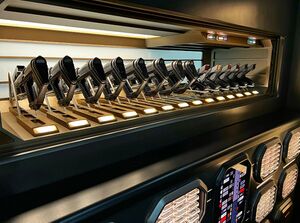
A veteran of the Dominion War of the 2360s, Captain Shavda came to appreciate the flexibility afforded by fielding a Hazard Team aboard her ship.
The Hazardous Situation Response Team, more commonly referred to as the Hazard Team, is a special unit stationed aboard many Starfleet vessels, intended for use on away missions and other situations where heavy combat is anticipated. Drawn from a starship or starbase’s personnel, these crewmembers take on additional duties of elite training and hazardous missions to step up when they are needed.
Despite this combat training and mission profile, Hazard Teams bring a wide range of technical, medical, and scientific skills to any operation, providing more versatility than a simple security team.
Due to the size of the Hikaru Sulu and the complexity of its mission profile, the ship fields no less than 4 active Hazard Teams, named after traditional Nipponese weapons:
- Hazard Team “Ōdachi”
- Hazard Team “Naginata”
- Hazard Team “Katana”
- Hazard Team “Iaitō” (a training unit)
The Hazard teams are led by the Hazard Team Leader, Lieutenant Keishara Dolan.
Auxiliary Craft
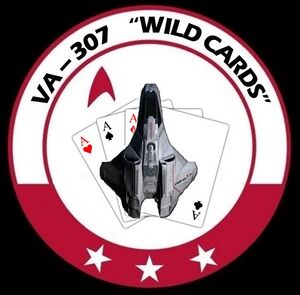
VA-307 - "Wildcards"
Embarked upon the Hikaru Sulu is a full Starfleet Starfighter Corps squadron, VA-307, otherwise known as the “Wildcards”. Operating the single–seat Valkyrie–class figher, the pilots of VA-307 are primarily assigned to Combat Air Patrol (CAP), border patrol, close escort, reconnaissance and Search & Rescue (SAR) operations to support the mission of the USS Hikaru Sulu.
The pilots of VA-307 are led by Squadron Leader Lieutenant Nylah “Nails” Burke & fall under the overall command of the Chief Flight Control Officer, Lieutenant Silou.
History
Originally assigned to service with First Fleet, after the original crew of the USS Hikaru Sulu suffered assimilation at the hands of the Borg Collective, during the disastrous events of Frontier Day, the Starfleet Corps of Engineers recovered the vessel and it underwent repair and refit at the Beta–Antares shipyards where it was originally laid down as one of the newer of this class to enter active service.
Assigned to the command of veteran Starfleet Captain Raveen Shavda, this prestigious command provides TF72 with an unparalleled ability to engage in purposeful multi-party diplomatic congress, First Contact engagement, deep–space exploration and humanitarian aid/disaster relief operations.
In 2402, the USS Hikaru Sulu became stranded in the former DMZ, by the encroachment achieved by the phenomena that became known as The Blackout, itself a precursor to a sudden and crippling attack, en-masse, by the forces of the Vanduwaar Supremacy who, using the Multicursal advantage of their mastery of Underspace, launched an all-out invasion of the Alpha & Beta Quadrants.

